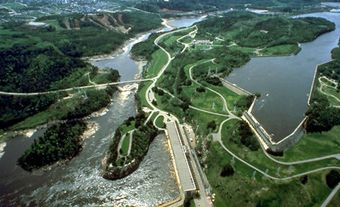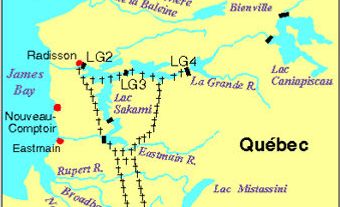Electric-power transmission lines carry power from generating plants (see electric-power generation) to the distribution systems that feed electricity to domestic, commercial and industrial users. Transmission lines vary from a few kilometres long in an urban environment to over 1000 km for lines carrying power from remote hydroelectric plants. They may differ greatly in the amount of power carried. Because requirements vary, many technical, economic and environmental factors must be considered when new lines are planned.
The basic modes of transmission are direct current (DC) and alternating current (AC). In direct current, the current flows in one direction only; in alternating current it reverses its direction many times per second. It is difficult to transform direct current from one voltage to another; hence, initially DC had to be transmitted at the low voltage at which it was generated and used. This fact limited its applicability: if transmission of large amounts of electricity or transmission over long distances was required, the cost of the conductor (copper wire) was prohibitive. Alternating current may be generated at a low voltage, boosted to a higher voltage by a transformer, transmitted and converted back to a lower voltage before use. Consequently, following the development of the transformer in the 1890s, most electricity was transmitted as AC.
However, DC transmission has a number of advantages and is being more widely used. For example, a DC line, requiring only 2 conductors instead of the 3 needed for an AC line, costs about two-thirds as much. Further, in DC transmission the effective voltage is equal to the peak voltage, while in AC transmission the peak voltage is 40% higher. Since radio interference increases with the peak voltage and decreases as the conductor size is increased, the DC system can carry a higher effective voltage than an AC line of equivalent size and still maintain an acceptable radio interference level. Thus, in some long lines carrying bulk power from remote generating sites, power is generated as AC, boosted to a high voltage, converted to DC for transmission, then reconverted to AC and transformed to a lower voltage for use. The cost of the converter stations at either end is offset by the lower cost of the line. An example of DC transmission is Manitoba's Nelson River line, which carries power from generating plants on the Nelson River to Winnipeg, almost 1000 km south. DC transmission is also advantageous for transmitting power through submarine cables, such as the line from the British Columbia mainland to Vancouver Island.
AC and DC can be transmitted in overhead lines or underground cables. The cost of underground cables is much greater than that of overhead lines, but this increase may be acceptable in urban areas where space for overhead lines is lacking or where aesthetics are a major concern. Transmission across bodies of water also requires the use of cables if the distance is too great to span with overhead lines.
Overhead power lines have 3 major components: support structure, insulation and conductors. Support structures can be wooden poles, free-standing steel towers or guyed towers of steel or aluminum. Glass or porcelain suspension insulators have traditionally separated the live conductors from the grounded towers. Each insulator consists of a metal cap on top and a metal pin underneath separated by the glass or porcelain insulation. These units are used to form insulator strings which vary in length depending on the voltage level and application. Several strings may be used in parallel to carry the weight of the conductors. For 735 kV about 30 insulators are used. New types of insulators have been developed using polymers; field testing and full-scale use became more prevalent during the 1980s. In the early days of electrical transmission, copper was used extensively as a conductor, but now virtually all conductors are aluminum. Each conductor is made of many strands (1-5 mm in diameter) combined to give an overall diameter of 4-50 mm. In most conductors, steel or a high-strength aluminum alloy is used for the core strands to give the conductor added strength. In a transmission line, up to 4 conductors may be used in parallel to form a conductor bundle.
Transmission voltages can vary considerably. Early in this century, Canada's fledgling power industry transmitted a few 10s of kilowatts (kW) of power over transmission lines operating at a few 10s of kilovolts (kV). Today one of Hydro-Quebec's James Bay transmission lines may carry over 2000 megawatts (MW) of power more than 1000 km at 735 kV. As the amount of power carried and the distances increased, it was necessary to increase the voltage to reduce losses and permit more power to be carried on a single line. Losses are proportional to distance and to the square of the current. Thus, for the same amount of power, if the voltage is doubled, the current is halved and the distance can be quadrupled for the same losses. Unfortunately, as voltages increase, so do costs: virtually everything must be larger and insulation problems become more complex. Electric power is generated at relatively low voltages, 25 kV or less. It must be transformed to a higher voltage for transmission, then transformed down to the distribution voltage, typically less than 25 kV. As the cost of the transformers also increases with voltage, the optimum voltage must be chosen carefully. For complex technical reasons, the use of higher transmission voltages is beneficial to the stability of the power system.
Because of the long transmission distances in this country, Canadian electrical utilities have often been pioneers in the field of transmission technology. As of 1982, Manitoba Hydro's Nelson River system, which began service in 1972, was the largest high-voltage DC transmission system in the world. In 1965 Hydro-Québec inaugurated its 735 kV Manicouagan line, thus becoming the first utility to go above 500 kV AC for transmission. Since even higher voltages will probably be needed in the future, the utilities are supporting research into transmission at voltages in excess of 1000 kV.

 Share on Facebook
Share on Facebook Share on X
Share on X Share by Email
Share by Email Share on Google Classroom
Share on Google Classroom



